oil pressure Alfa Romeo 166 2006 Owner handbook (in English)
[x] Cancel search | Manufacturer: ALFA ROMEO, Model Year: 2006, Model line: 166, Model: Alfa Romeo 166 2006Pages: 272, PDF Size: 4.17 MB
Page 75 of 272
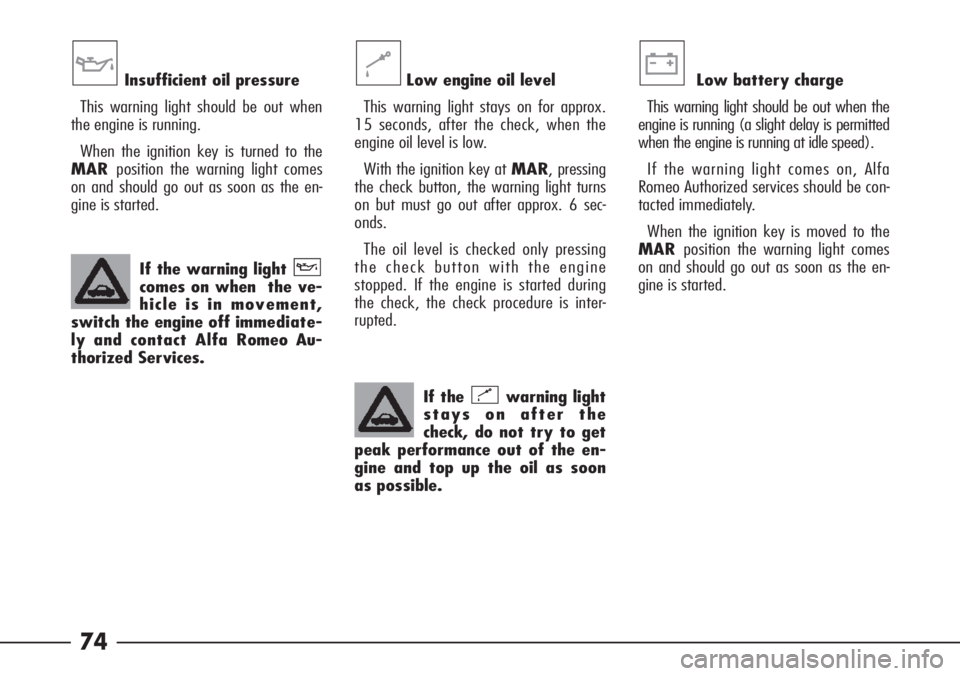
74
If the warning light
comes on when the ve-
hicle is in movement,
switch the engine off immediate-
ly and contact Alfa Romeo Au-
thorized Services.v
Low engine oil level
This warning light stays on for approx.
15 seconds, after the check, when the
engine oil level is low.
With the ignition key at MAR, pressing
the check button, the warning light turns
on but must go out after approx. 6 sec-
onds.
The oil level is checked only pressing
the check button with the engine
stopped. If the engine is started during
the check, the check procedure is inter-
rupted.k
If the warning light
stays on after the
check, do not try to get
peak performance out of the en-
gine and top up the oil as soon
as possible.k
Insufficient oil pressure
This warning light should be out when
the engine is running.
When the ignition key is turned to the
MARposition the warning light comes
on and should go out as soon as the en-
gine is started. vLow battery charge
This warning light should be out when the
engine is running (a slight delay is permitted
when the engine is running at idle speed).
If the warning light comes on, Alfa
Romeo Authorized services should be con-
tacted immediately.
When the ignition key is moved to the
MARposition the warning light comes
on and should go out as soon as the en-
gine is started.w
Page 149 of 272
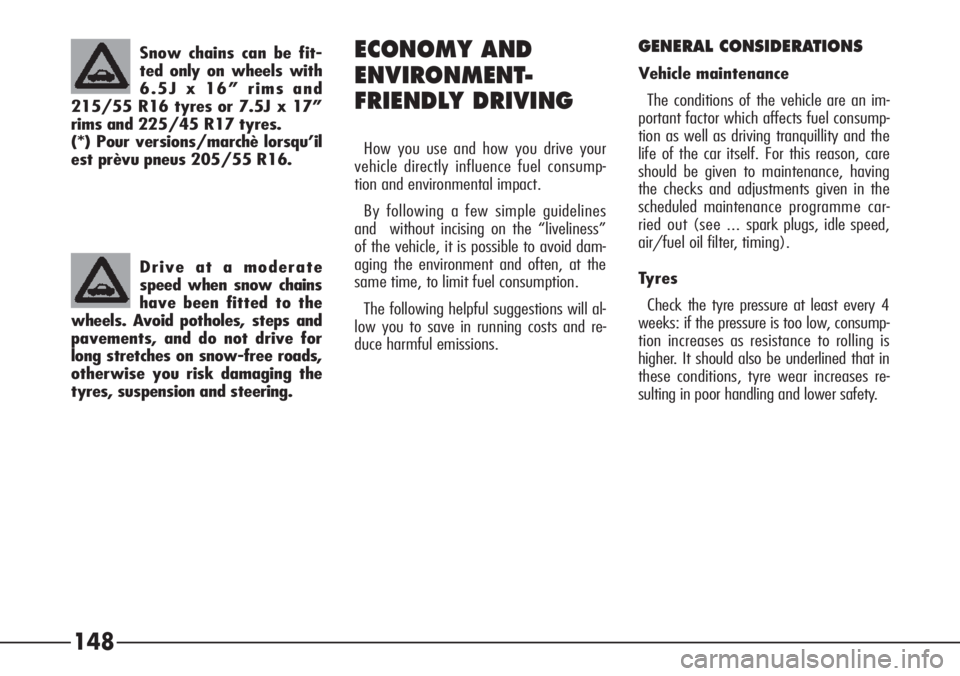
148ECONOMY AND
ENVIRONMENT-
FRIENDLY DRIVING
How you use and how you drive your
vehicle directly influence fuel consump-
tion and environmental impact.
By following a few simple guidelines
and without incising on the “liveliness”
of the vehicle, it is possible to avoid dam-
aging the environment and often, at the
same time, to limit fuel consumption.
The following helpful suggestions will al-
low you to save in running costs and re-
duce harmful emissions.
GENERAL CONSIDERATIONS
Vehicle maintenance
The conditions of the vehicle are an im-
portant factor which affects fuel consump-
tion as well as driving tranquillity and the
life of the car itself. For this reason, care
should be given to maintenance, having
the checks and adjustments given in the
scheduled maintenance programme car-
ried out (see ... spark plugs, idle speed,
air/fuel oil filter, timing).
Tyres
Check the tyre pressure at least every 4
weeks: if the pressure is too low, consump-
tion increases as resistance to rolling is
higher. It should also be underlined that in
these conditions, tyre wear increases re-
sulting in poor handling and lower safety. Drive at a moderate
speed when snow chains
have been fitted to the
wheels. Avoid potholes, steps and
pavements, and do not drive for
long stretches on snow-free roads,
otherwise you risk damaging the
tyres, suspension and steering.
Snow chains can be fit-
ted only on wheels with
6.5J x 16” rims and
215/55 R16 tyres or 7.5J x 17”
rims and 225/45 R17 tyres.
(*) Pour versions/marchè lorsqu’il
est prèvu pneus 205/55 R16.
Page 156 of 272
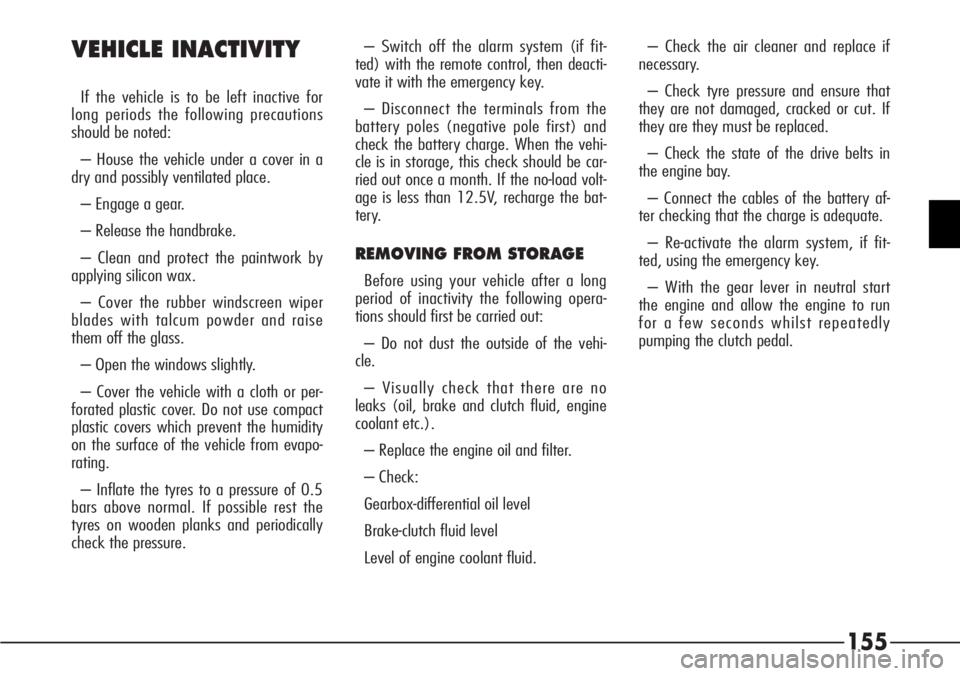
155 VEHICLE INACTIVITY
If the vehicle is to be left inactive for
long periods the following precautions
should be noted:
– House the vehicle under a cover in a
dry and possibly ventilated place.
– Engage a gear.
– Release the handbrake.
– Clean and protect the paintwork by
applying silicon wax.
– Cover the rubber windscreen wiper
blades with talcum powder and raise
them off the glass.
– Open the windows slightly.
– Cover the vehicle with a cloth or per-
forated plastic cover. Do not use compact
plastic covers which prevent the humidity
on the surface of the vehicle from evapo-
rating.
– Inflate the tyres to a pressure of 0.5
bars above normal. If possible rest the
tyres on wooden planks and periodically
check the pressure.– Switch off the alarm system (if fit-
ted) with the remote control, then deacti-
vate it with the emergency key.
– Disconnect the terminals from the
battery poles (negative pole first) and
check the battery charge. When the vehi-
cle is in storage, this check should be car-
ried out once a month. If the no-load volt-
age is less than 12.5V, recharge the bat-
tery.
REMOVING FROM STORAGE
Before using your vehicle after a long
period of inactivity the following opera-
tions should first be carried out:
– Do not dust the outside of the vehi-
cle.
– Visually check that there are no
leaks (oil, brake and clutch fluid, engine
coolant etc.).
– Replace the engine oil and filter.
– Check:
Gearbox-differential oil level
Brake-clutch fluid level
Level of engine coolant fluid.– Check the air cleaner and replace if
necessary.
– Check tyre pressure and ensure that
they are not damaged, cracked or cut. If
they are they must be replaced.
– Check the state of the drive belts in
the engine bay.
– Connect the cables of the battery af-
ter checking that the charge is adequate.
– Re-activate the alarm system, if fit-
ted, using the emergency key.
– With the gear lever in neutral start
the engine and allow the engine to run
for a few seconds whilst repeatedly
pumping the clutch pedal.
Page 207 of 272
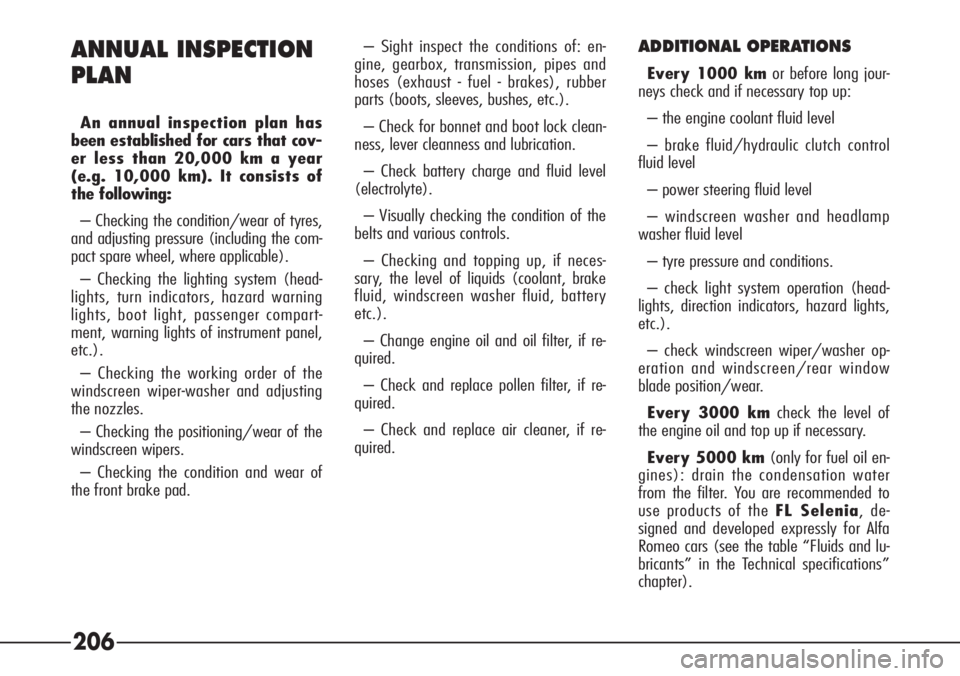
206 ANNUAL INSPECTION
PLAN
An annual inspection plan has
been established for cars that cov-
er less than 20,000 km a year
(e.g. 10,000 km). It consists of
the following:
– Checking the condition/wear of tyres,
and adjusting pressure (including the com-
pact spare wheel, where applicable).
– Checking the lighting system (head-
lights, turn indicators, hazard warning
lights, boot light, passenger compart-
ment, warning lights of instrument panel,
etc.).
– Checking the working order of the
windscreen wiper-washer and adjusting
the nozzles.
– Checking the positioning/wear of the
windscreen wipers.
– Checking the condition and wear of
the front brake pad.– Sight inspect the conditions of: en-
gine, gearbox, transmission, pipes and
hoses (exhaust - fuel - brakes), rubber
parts (boots, sleeves, bushes, etc.).
– Check for bonnet and boot lock clean-
ness, lever cleanness and lubrication.
– Check battery charge and fluid level
(electrolyte).
– Visually checking the condition of the
belts and various controls.
– Checking and topping up, if neces-
sary, the level of liquids (coolant, brake
fluid, windscreen washer fluid, battery
etc.).
– Change engine oil and oil filter, if re-
quired.
– Check and replace pollen filter, if re-
quired.
– Check and replace air cleaner, if re-
quired.
ADDITIONAL OPERATIONS
Every 1000 kmor before long jour-
neys check and if necessary top up:
– the engine coolant fluid level
– brake fluid/hydraulic clutch control
fluid level
– power steering fluid level
– windscreen washer and headlamp
washer fluid level
– tyre pressure and conditions.
– check light system operation (head-
lights, direction indicators, hazard lights,
etc.).
– check windscreen wiper/washer op-
eration and windscreen/rear window
blade position/wear.
Every 3000 kmcheck the level of
the engine oil and top up if necessary.
Every 5000 km(only for fuel oil en-
gines): drain the condensation water
from the filter. You are recommended to
use products of the FL Selenia, de-
signed and developed expressly for Alfa
Romeo cars (see the table “Fluids and lu-
bricants” in the Technical specifications”
chapter).
Page 232 of 272
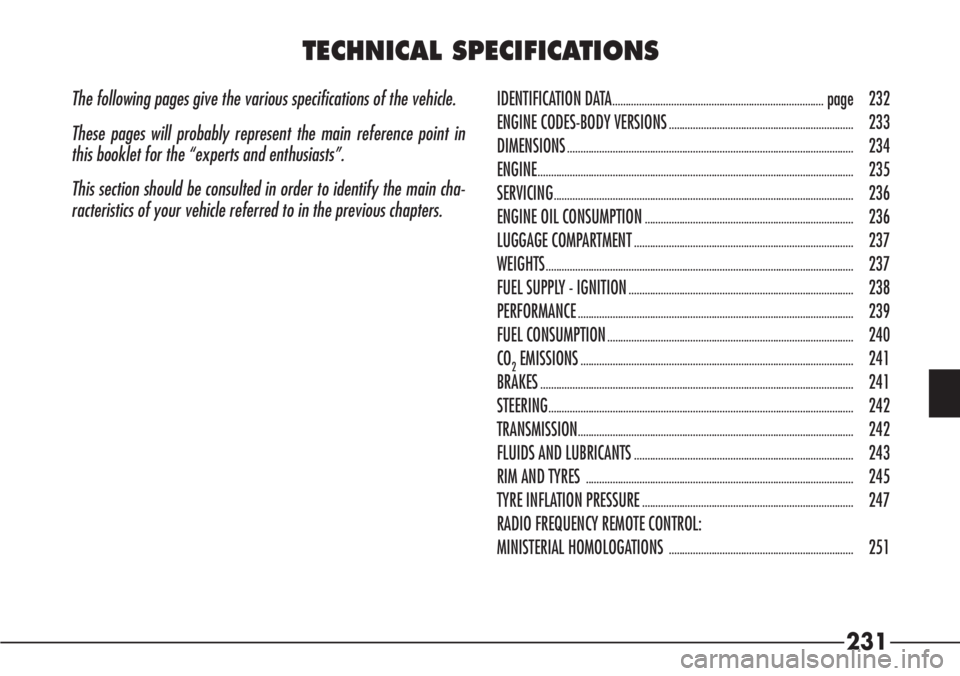
231
The following pages give the various specifications of the vehicle.
These pages will probably represent the main reference point in
this booklet for the “experts and enthusiasts”.
This section should be consulted in order to identify the main cha-
racteristics of your vehicle referred to in the previous chapters.IDENTIFICATION DATA...............................................................................page 232
ENGINE CODES-BODY VERSIONS
.....................................................................233
DIMENSIONS
...........................................................................................................234
ENGINE
......................................................................................................................235
SERVICING
................................................................................................................236
ENGINE OIL CONSUMPTION
..............................................................................236
LUGGAGE COMPARTMENT
..................................................................................237
WEIGHTS
...................................................................................................................237
FUEL SUPPLY - IGNITION
....................................................................................238
PERFORMANCE
.......................................................................................................239
FUEL CONSUMPTION
............................................................................................240
CO
2EMISSIONS......................................................................................................241
BRAKES
.....................................................................................................................241
STEERING
..................................................................................................................242
TRANSMISSION
.......................................................................................................242
FLUIDS AND LUBRICANTS
..................................................................................243
RIM AND TYRES
....................................................................................................245
TYRE INFLATION PRESSURE
...............................................................................247
RADIO FREQUENCY REMOTE CONTROL:
MINISTERIAL HOMOLOGATIONS
.....................................................................251
TECHNICAL SPECIFICATIONS
Page 271 of 272
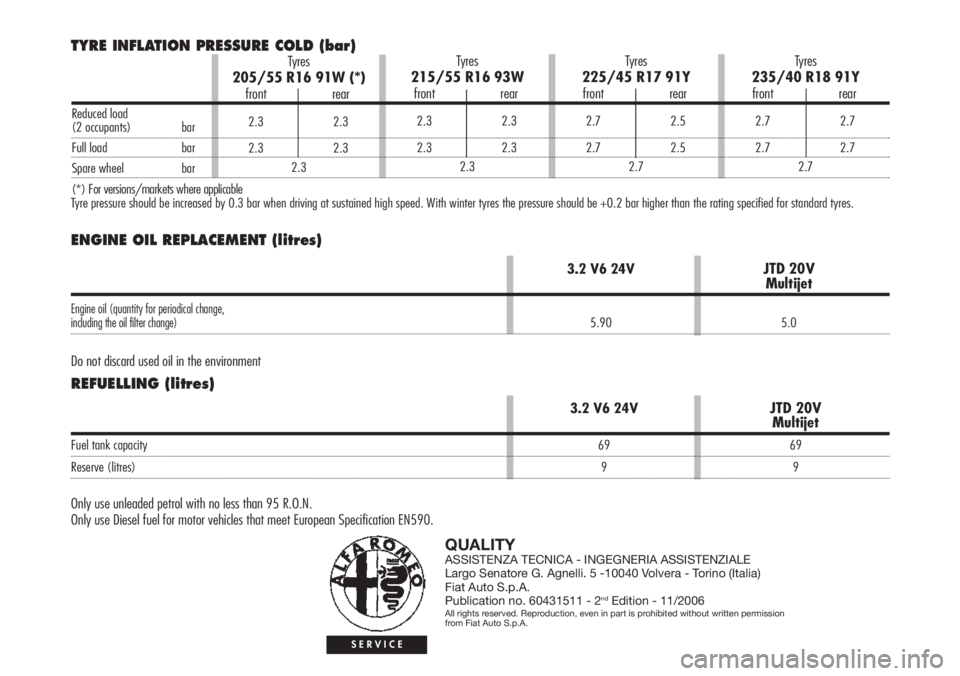
Tyre pressure should be increased by 0.3 bar when driving at sustained high speed. With winter tyres the pressure should be +0.2 bar higher than the rating specified for standard tyres.
ENGINE OIL REPLACEMENT (litres)
Do not discard used oil in the environment
REFUELLING (litres)
Only use unleaded petrol with no less than 95 R.O.N.
Only use Diesel fuel for motor vehicles that meet European Specification EN590.
QUALITYASSISTENZA TECNICA - INGEGNERIA ASSISTENZIALE
Largo Senatore G. Agnelli. 5 -10040 Volvera - Torino (Italia)
Fiat Auto S.p.A.
Publication no. 60431511 - 2
ndEdition - 11/2006All rights reserved. Reproduction, even in part is prohibited without written permission
from Fiat Auto S.p.A.
SERVICE
3.2 V6 24VJTD 20VMultijet
Engine oil (quantity for periodical change,including the oil filter change)5.90 5.0
3.2 V6 24VJTD 20VMultijet
Fuel tank capacity 69 69
Reserve (litres) 9 9
TYRE INFLATION PRESSURE COLD (bar)Tyres215/55 R16 93Wfront rear
2.3 2.3
2.3 2.3
2.3
Tyres205/55 R16 91W (*)front rear
2.3 2.3
2.3 2.3
2.3
Tyres225/45 R17 91Yfront rear
2.7 2.5
2.7 2.5
2.7
Tyres235/40 R18 91Yfront rear
2.7 2.7
2.7 2.7
2.7Reduced load(2 occupants) bar
Full load bar
Spare wheel bar
(*) For versions/markets where applicable